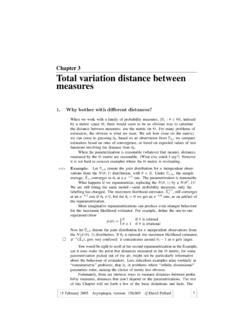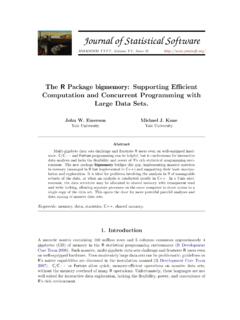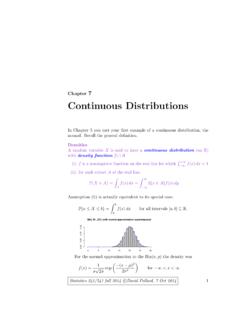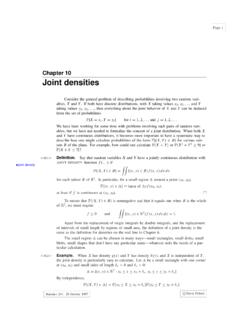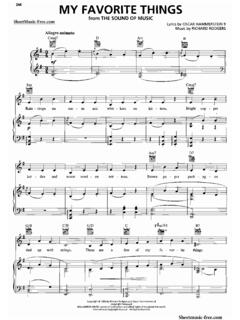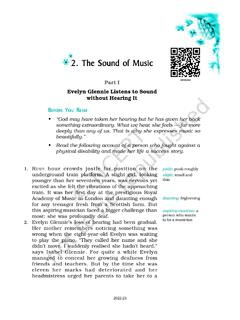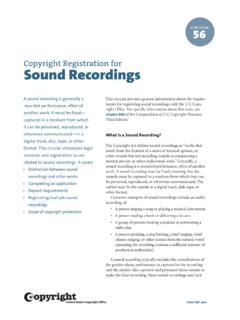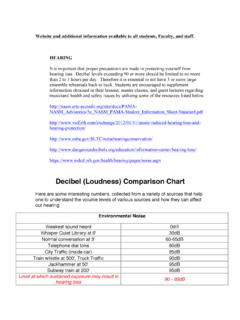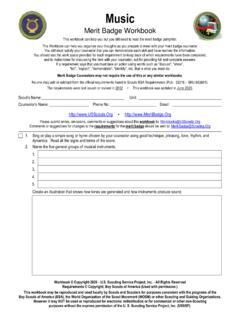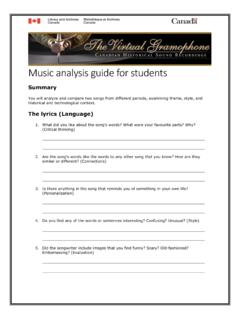Transcription of Seminar Notes: The Mathematics of Music - Yale University
1 Seminar Notes: The Mathematics of MusicZhou FanSeptember 1, 20102 ContentsPrefaceiii1 Understanding Musical sound , the human ear, and the sinusoidal wave .. waves and musical notation .. human ear and the sinusoidal wave .. Timbre and resonance harmonics .. Fourier series and frequency analysis .. Further topics .. instruments .. phenomena ..82 Chords, Scales, and the Fundamentals of Western Consonance and dissonance .. Scales and temperament .. fractions and the twelve-tone scale.
2 Intonation, Euclidean lattices, and the fundamental domain .. , irregular, and equal temperament .. The Javanese gamelan ..173 Musical Structure and Musical symmetries and transformations .. , generators, and relations .. transformations .. between major and minor triads .. of motifs and melodic passages .. in Debussy sFeux d artifice.. The geometry of chords .. of ordered chords .. of unordered chords .. descending chord progressions ..30 Bibliographic Notes33iiiCONTENTSP refaceThese notes were created as a set of lecture notes for a three-day Seminar on the Mathematics of Music ,intended to introduce topics in this area to the interested reader without assuming strong prerequisitesin Mathematics or Music theory.
3 They are not intended to be a comprehensive and technically rigorousexposition, and an attempt is made to introduce the concepts in an elementary way and to avoid technicaldetails when possible and appropriate. Much has been written on the connections between Mathematics andmusic; this summary draws on a number of such sources, referenced to in the bibliographic 1 Understanding Musical sound , the human ear, and the sinusoidal sound waves and musical notationMusic is organized sound , and it is from this standpoint that we begin our study.
4 In the world of Westernmusic, notation has been developed to describe Music in a very precise way. Consider, for instance, thefollowing lines of Music :A musician who understands this notation would recognize this as the melody of Twinkle, Twinkle LittleStar (in the key of A major), and the symbols above encode, to great precision, various aspects of thesounds that make up this travels through air, a gaseous medium of molecules that are constantly in motion and exertingforces against each other.
5 These forces createair pressure when a large quantity of air molecules arecompressed in a small space, air pressure is high, and when air molecules are spread out at a great distancefrom one another, air pressure is low. Physically, sound is awaveof alternating high and low air pressurethat travels through time and visualize a sound wave, let us consider a chronological sequence of pictures of the compression of airmolecules for a sound wave moving in the rightward direction:12 LECTURE 1. UNDERSTANDING MUSICAL SOUNDOne should note that each individual air molecule moves only a very small distance and does not travelfar in the rightward direction, but rather that a rippling effect causes the wave to propagate these pictures are graphs of the air pressure at each point in space.
6 Where we shift our unitsso that the horizontal axis indicates normal atmospheric air pressure without the perturbation of shape of the functions in these graphs is called thewaveform. We have drawn the wave to beperiodic,meaning that it is a repetition of the same pattern across space, and indeed, a musical pitch corresponds toa periodic sound wave. The distance in space between two repetitions of the pattern is called thewavelengthof the wave or theperiodof the waveform. If we focus on how the wave moves through a particular point inspace, the number of repetitions of the pattern that move through that point in a single second is called thefrequencyof the wave, measured in Hertz (Hz).
7 For waves moving at the same speed, a longer wavelengthimplies a longer time for a single repetition of the pattern to move across any given point, and hence itimplies a lower frequency. Indeed, we have the relationship frequency wavelength = speed of wave. Forthis particular waveform, known as the sinusoidal wave, there is a clear maximum and minimum amount ofair pressure achieved by the wave, and the difference between this and normal atmospheric pressure is calledtheamplitudeof the to our musical example of Twinkle, Twinkle Little Star , we may translate the musicalnotation into statements about the physical waves that make up the sound .
8 The first and last notes of theexample are A above middle C , which refers to the pitch of the note, a musical term for the frequency ofthe sound wave. This A above middle C has a frequency of 440Hz, and it is common to see the marking A440 on digital tuners to represent this pitch. Every musical pitch corresponds to a particular frequency for instance, the third note of E in the musical example is a frequency of 660Hz with higher pitchescorresponding to higher frequencies and lower pitches corresponding to lower frequencies.
9 The markingmpis a dynamic marking to indicate the volume of the sound , which corresponds to the amplitude of the soundwave. Finally, the stems and heads of the notes indicate the duration of each note, which is the amount oftime a particular sound wave is present before it changes to the next The human ear and the sinusoidal waveHow does the ear perceive sound and distinguish pitch? A picture of the ear is shown outer ear, composed of the pinna, concha, and auditory canal, is responsible for amplifying sound andplays an important role in our ability to perceive the location of a sound source.
10 sound waves passing throughthe auditory canal create oscillations of the tympanic membrane that separates the outer and middle membrane is attached to three bones known as the ossicles, which in turn are attached to a liquid-filledtube called thecochleain the inner ear. The ossicles transfer the oscillations of the tympanic membrane towaves in the liquid of the cochlea, and it is the cochlea that plays the main role in pitch TIMBRE AND RESONANCE HARMONICS3 The above image shows a picture of a cross-section of the uncoiled cochlea.




